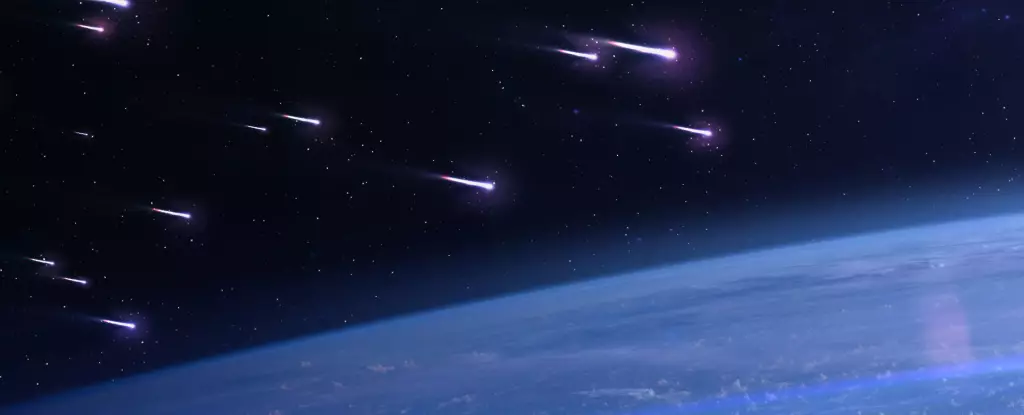Every year, skywatchers around the globe eagerly anticipate the Leonid meteor shower, an event that has captivated stargazers for centuries. This astronomical phenomenon, characterized by its brilliant meteors streaking across the night sky, originates from the periodic comet 55P/Tempel-Tuttle. With the potential for dramatic displays, including meteor storms, the Leonids have garnered a reputation for being one of the most thrilling meteor showers to observe. The excitement builds as we prepare for this year’s shower, especially given the intriguing forecasts surrounding it.
Nostalgic Reflections on Past Leonid Displays
The magic of the Leonid meteor shower is best appreciated through personal anecdotes, such as the experience of witnessing its grandeur during the late 1990s. In November 1998, a deployment to the expansive dark skies of Kuwait offered an enchanting encounter with the meteor shower at its peak. As dawn approached on November 17th, the night sky erupted with meteors, illuminating the desert landscape in a dazzling display reminiscent of celestial fireworks. With a fireball flurry resulting in “photoflashes” against the dark backdrop, the event left indelible memories that continue to inspire a sense of wonder.
What sets the Leonid meteor shower apart is its periodic nature, returning in stunning displays every 33 years, when Earth passes through the densest regions of debris left by the comet. The last significant outburst occurred around the turn of the century, but discussions of potential activity in the years to come—specifically in 2024—are generating excitement among astronomy enthusiasts.
As we approach November 2024, predictions indicate that this year may be an “off year” for the Leonids. The anticipated peak is projected for the early hours of November 17th, with expectancies ranging from 15 to 20 meteors per hour under ideal conditions. The best view is likely to be in Europe, where the light of dawn enhances the spectacle. However, meteor enthusiasts won’t want to overlook an additional opportunity earlier in the week, as the Earth will interact with older streams associated with the Leonid meteor shower.
Expert Jérémie Vaubaillon from the Paris Observatory has noted that Earth might encounter three ancient trails of debris from previous interactions with comet 55P/Tempel-Tuttle. These earlier streams, particularly the trails from the years 1633 and 1733, present intriguing opportunities for visual activity, especially on November 14th, when the northwestern region of North America may get an exceptional show.
Challenges for Observers
Unfortunately, conditions for optimal visibility in November 2024 may not be ideal, as there will be a waxing gibbous Moon approaching full illumination by November 15th. The increasing brightness may significantly diminish the number of visible meteors, making the task of spotting them more challenging for casual observers. While recent years have typically yielded rates around 20 meteors per hour, the climatic conditions of 2024 prompt participants to remain hopeful for any surprise displays.
Meteor showers reach their astronomical zenith during periods known as “outbursts,” characterized by extraordinarily high Zenithal Hourly Rates (ZHR). In some instances, ZHRs can soar to astounding numbers, such as the 1966 outburst that reportedly reached a staggering 150,000 meteors per hour! In contrast, other meteor showers, like the October Draconids or December Andromedids, can also produce remarkable displays but lack the same notoriety as the Leonids.
For those eager to catch a glimpse of the upcoming meteors, timing and technique are crucial. The early morning hours provide the best chances for sighting shooting stars, as the Earth rotates into the path of the debris cloud. Observers should expect meteors to appear near the radiant point in the constellation Leo while also being attentive to long, radiant trails extending outward.
If capturing the experience on camera is a priority, the use of a DSLR camera mounted on a tripod can yield impressive results. By adjusting the camera settings to the widest field of view and utilizing an intervalometer for automated shots, observers can enjoy the spectacle without missing a moment. With a warm drink in hand, the tranquility of watching the meteor shower unfold is an experience unlike any other.
While 2024 may not bring the strongest Leonid meteor shower in recent years, the possibility of unexpected showdowns and light displays makes it worthwhile to watch the sky. As we look ahead to the upcoming months, we should embrace the mysterious nature of the cosmos and its potential to surprise us. Those who choose to venture out, regardless of the expected rates, may be rewarded with a breathtaking celestial spectacle. Who knows? The night sky may hold secrets and beauty waiting to be discovered, even as we await a more robust Leonid event in 2030. So, armed with curiosity and a sense of adventure, let us not risk missing a chance to watch in wonder.


Leave a Reply